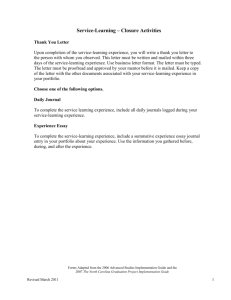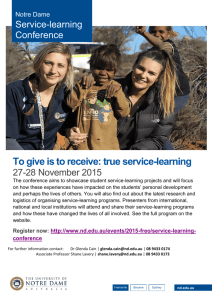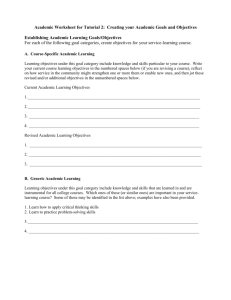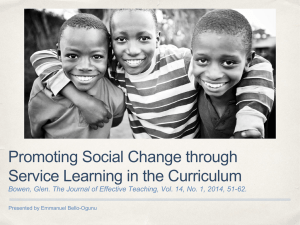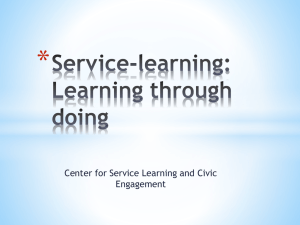The State Farm Southern Zone Youth Advisory Board
advertisement
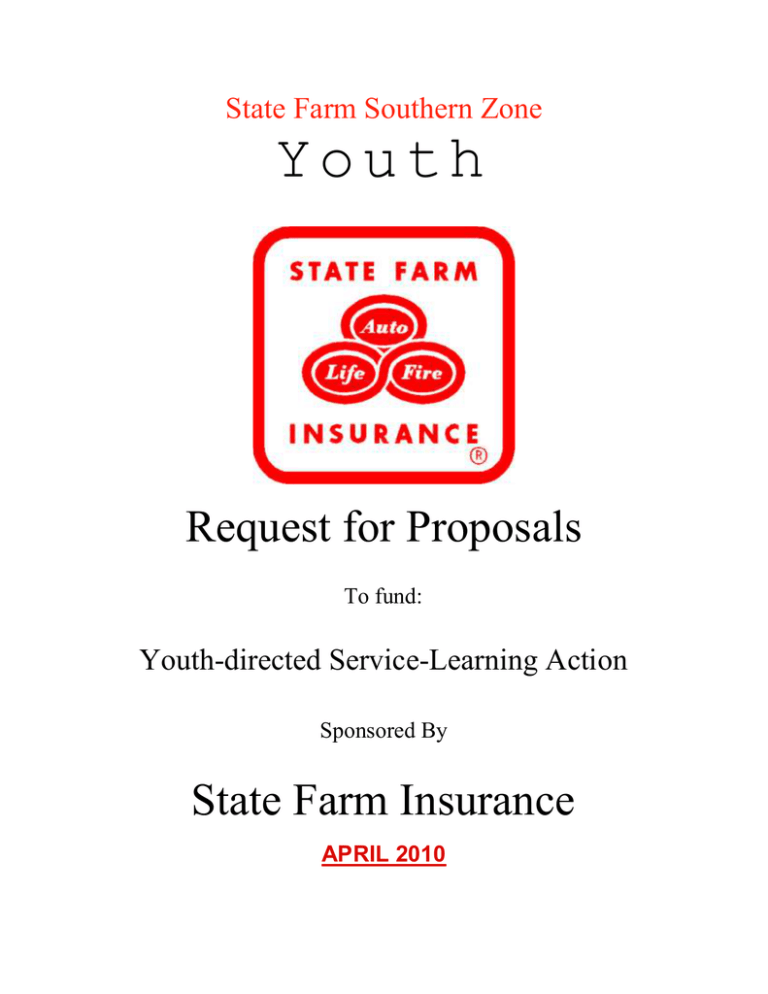
State Farm Southern Zone Youth Advisory Board Request for Proposals To fund: Youth-directed Service-Learning Action Sponsored By State Farm Insurance APRIL 2010 State Farm Southern Zone Yo u t h Ad v i s o r y B o a r d Background The Board Service-Learning Mandatory Requirements Funding Levels Issue Analyses The Application Checklist Contact Sheet RFP Narrative Budget Table of Contents State Farm Southern Zone Yo u t h Ad v i s o r y B o a r d The Board The State Farm Southern Zone Youth Advisory Board The State Farm Southern Zone Youth Advisory Board is a diverse group of 8-10 students aged 17-21. They play a leadership role in creating and overseeing a $75,000 State Farm funded service-learning initiative. Their work is truly youth-led and youth-driven. They are a subset of the Corporate State Farm Youth Advisory Board. The Southern Zone Board grants funds for student-led service-learning projects in the State Farm Southern Zone, comprised of Alabama, Mississippi, Georgia and South Carolina. These grants address in a structural way the issues of financial education, driver safety, access to higher education and environmental responsibility. The number of grants to be awarded will depend on the number and quality of request received. Grant amounts will vary according to the nature of the proposal and availability of funds. Applicants may only apply for one year grants. There are four (4) types of grant given by the Southern Zone Board. There will be three (3) levels of service-learning grants offered to schools and programs: Emerging, Expansion, and Exemplary. Grant request are due by Sunday, August 1st ,2010. Notifications will be made by the first week of September by email and phone. Southern Zone Youth Advisory Board Members Alabama Taylor Peake - taylorpeake@gmail.com Gabe Hyde – ghyde@samford.edu South Carolina Damaris Taylor – djtaylor@fas.harvard.edu Gabe Fonseca – gabe.fonseca@yahoo.com Mississippi Tirranny Nettles - tirrannynettles@gmail.com Jenny My Ngo (Chair) - myngoj@gmail.com State Farm Employee Advisors Bruce White - bruce.white.gkmd@statefarm.com Emily Clark - emily.clark.lvlo@statefarm.com Mission Statement The State Farm Southern Zone Youth Advisory Board seeks to improve the lives of youth and impact communities through the support of youth-led service-learning projects. Therefore, we believe that: Youth bring insightful and unique perspective. The State Farm Southern Zone Youth Advisory Board is responsible for advocating on behalf on its peers. Board members should invest their passion into the board’s mission. The board should act in the best interest of State Farm, its agents, associates and customers. State Farm Southern Zone Yo u t h Ad v i s o r y B o a r d Service-Learning Service-Learning Grants are given out in support of service learning projects NOT community service projects. Please ensure that you have reviewed the distinct qualities of service-learning that differentiate it as a teaching strategy from community service prior to the completion of the application. Most people learn by doing, rather than merely hearing or reading. That’s where service-learning adds value. Service-learning is a teaching method which supplements the classroom studies with hands-on projects that address pressing community issue and problems. When students have the opportunity to apply what they are learning to authentic problem solving, the result is too powerful to contain in a textbook. Service-learning ensures that a project not only benefits the “target audience,” but also the young people who are active participants in designing and executing the work. Types of Service-Learning Direct Service-Learning - Positions youth in direct contact with people that results in working with a diverse population. Example: Students working at a soup kitchen to provide food to the hungry and homeless. Indirect Service-Learning - Engages youth in performing service by activities that occur at school and channels resources to an area of need. Example: Math students collecting canned food for the local food bank while keeping a bar graph of the number of cans collected per week. Advocacy Service-Learning - Provides the opportunity to participate in policy change by youth contributing voices and talents to help eliminate the causes of a specific problem. Example: Students in a US Government class research state seatbelt law and lobby local legislators to push for stricter laws to decrease the number of “no seatbelt”-related deaths. Standards of Quality Service-Learning Practice In 2008 the National Youth Leadership Council released 8 research-based Standards of Quality Service-Learning Practice. These standards are components that research shows are present in high quality service learning projects. 1. Curriculum Integration: embedding service-learning experiences in curricular goals and standards that drive student learning of concepts, content and skills in academic disciplines and co-curricular settings. 2. Reflection: facilitating continuous reflection before, during, and after the service experiences - using multiple, cognitively challenging methods to encourage critical and creative thinking that addresses learning experiences. 3. Youth Voice: engaging the vision and leadership of young people as valued contributors to society by integrating their ideas into the selection, design, implementation, and evaluation of service-learning experiences. 4. Diversity: fostering civil discourse and democratic values through the inclusion of diverse perspectives and experiences, and through a respect for all learners. 5. Meaningful Service: applying problem-solving and critical thinking skills to community and civic needs in real-world environments. 6. Progress Monitoring: analyzing student reflections and assessment measures, in combination with project and partner evaluation data, for continuous review and improvement. 7. Duration & Intensity: ensuring that service and learning experiences are of sufficient intensity and duration (or are equal to one semester), so that all phases of planning, through project evaluation, are included. 8. Reciprocal Partnerships: leveraging community assets and promoting collaborative communication and interaction among stakeholders. State Farm Southern Zone Yo u t h Ad v i s o r y B o a r d Mandatory Requirements Mandatory Requirements In order to be eligible to receive a grant from the State Farm Southern Zone Youth Advisory Board, the following should be true or clearly evident: o Applicants should be educators who currently teach in a public K-12, charter, or higher education institution. o Organizations/institutions must be located in South Carolina, Alabama, Georgia, or Mississippi. o Non-profit organizations, those organizations falling under §501(c)3 of United States Tax Code, are also eligible to apply if they are able to demonstrate how they plan to ACTIVELY PARTNER with students in PUBLIC K-12 schools and cite the specific schools/classes with which they will be working. o The RFP must address a community need through service-learning NOT community service (see the section on Service Learning or for more information visit: www.service-learning.org) o The RFP must include promotion of State Farm and the State Farm Southern Zone Youth Advisory Board through media outreach and project marketing. o Grant winners must complete the Memorandum of Agreement according to the published timeline. Please carefully read and consider the above requirements before reading and completing the rest of the application. If you have any questions regarding the requirements or specifications please do not hesitate to contact your local Southern Zone Board member for clarification or further explanation. State Farm Southern Zone Yo u t h Ad v i s o r y B o a r d Funding Levels For this year’s grant cycle, the Board will be implementing separate funding levels for which organizations may apply. These funding levels reflect the Board’s commitment to excellence by attempting to provide the teachers, students, and service-learning stakeholders in the Southern Zone, with a more focused and powerful grant-making tool. Please take the time to read each of the funding levels carefully and determine which level of funding your organization has the best capacity to implement. Please consider that these three levels of funding represent steps in the overall process of service-learning programming in your organization. It is the expectation of the Board that grantees who apply as Emerging or Expanding grantees will grow the next year so that they may reach the next funding level. The Board intends to use these three levels of funding to create growth in the collective knowledge of service-learning in the Southern Zone. Organizations should, over time, progress from one funding level to the next, until the organization is ready to apply for a Corporate grant to institutionalize their service-learning programs across their district, or other large educational entity. Emerging These grantees are service-learning programs or projects that are in the initial stages of planning and development. Practitioners applying for Emerging level grants may only have a novice knowledge and experience in service-learning pedagogy. The goal of Emerging grants is to provide funds so that service-learning may begin to take root in schools and communities. Funds would be used for professional development, technical assistance, and rudimentary project implementation. Expansion This level of funding is for organizations that have an intermediate amount of service-learning experience. Practitioners working with students to implement the service-learning should have service-learning training and should be well-versed in the educational theory of service-learning. Organizations may have pockets of service-learning present throughout their entire program, but there is a lack of true (not nominal) central coordination and coherency. Funds would be used for the implementation of projects (under a central initiative) and further training. Exemplary This level of funding is specifically targeted at organizations with an expert knowledge of servicelearning and the beginnings of true systemic service-learning throughout their program. Practitioners in this category of funding are very well-versed in service-learning theory and have had multiple experiences with service-learning. Service-learning initiatives being undertaken by the youth are coordinated centrally and coherently. Applicants at this level are well on their way to applying for a Corporate YAB Grant to institutionalize their service-learning programs. Funds would be used for the further unification of service-learning efforts and for the funding of multifaceted youth-led initiatives. State Farm Southern Zone Yo u t h Ad v i s o r y B o a r d Issue Analyses Financial Education Knowledge of financial education is an important life-skill needed by anyone in any country. Without preparation, a person will be less likely to buy a house at a good rate, know a good interest rate for a loan, know how to buy a car and avoid unnecessary fees, or know how to save their money. Service-learning grants addressing this community need should aim to educate students about practical financial skills. Driver Safety The World Health Organization (WHO) estimates that “25 percent of all deaths due to injuries are the result of road traffic injuries”1. The leading causes of traffic and traffic-related deaths include impaired driving, improper or lack of use of seat belts and speeding. Driver safety also includes: child-passenger safety, graduated licensing, senior citizen safety, road rage, street racing, road engineering, and railroad crossing safety. Service-learning grants addressing this community need should engage students in promoting awareness of this issue and changing driving habits of peers and community members to decrease the number of traffic related deaths and injuries. Access to Higher Education Attending a two or four year institution of higher education is becoming increasingly necessary to enter the workforce. It is clear that service-learning is one of the most effective tools for helping increase attrition rates from secondary to higher education institutions. By helping to engage them in their educational experiences and educating them about the importance of college/university attendance, service-learning projects/programs can help make accessing higher education a more achievable goal for many students. Servicelearning grants addressing this community need should help students build skills necessary to enter a higher education institution and help expose students (especially minority students) to higher education institutions. Environmental Responsibility One of the most current and rapidly growing concerns in the 21st century, is that of Environmental Responsibility. Topics for consideration in this ongoing public discourse have been climate change, ozone depletion, conservation of natural resources, wildlife protection which are just a few of a myriad of concerns. By starting grassroots efforts through servicelearning programs in this issue area, youth can help bring about systemic change for the betterment of the worldwide community. Service-learning grants addressing this community need should encourage environmental responsibility in students and community members via advocacy and to help directly and/or indirectly impact local environmental factors. 1 Juan Walte, “World Health Day 2004: Road Safety”, http://www.paho.org/English/DD/PIN/whd04_features.htm (2004) State Farm Southern Zone Yo u t h Ad v i s o r y B o a r d Checklist of Required Materials Prior to the submission of your application, please take the time to verify that all of the following have been completed and are included in your application packet. In addition, please review your application to ensure that you have provided all of the information necessary for the Board to decide whether or not your proposal should be funded. _____ Letterhead of Request on Organization Letterhead2 _____ Completed Contact Sheet _____ Completed Proposal Narrative _____ Completed Timeline _____ Completed Budget Please submit applications by Sunday, August 1st, 2010 to: The Southern Zone Youth Advisory Board sfszyab@gmail.com If you have any questions, comments, concerns, or points that require further clarification please contact any of the Southern Zone YAB members or their State Farm Liaisons. 2 Letters of request must include the Federal Tax ID # (EIN) of the submitting organization. State Farm Southern Zone Yo u t h Ad v i s o r y B o a r d Adult (must be legally authorized to sign on the behalf of the organization): Name of Applicant: _________________________________ Name of School/Organization: _________________________________ Occupation: ______________________________ Work Phone: ________________________ Cell Phone: _________________________ Summer Break Phone: ________________________________ Email: _______________________________ School/Organization Mailing Address: ______________________________ Street ____________________, _________ ____________ City State Zip Code Signature: _____________________________________________, Date: _____________ Youth Applicant (co-author of proposal) Name of Applicant: _________________________________ Summer Break Phone: ______________________ Cell Phone: ________________ Email: __________________________________________ By signing below you are confirming that you helped to directly craft and write the attached proposal, timeline, and budget. In addition, by signing you are acknowledging that you are aware that during the grant review process you may be contacted regarding your role in the creation of this proposal. Signature: _____________________________________________, Date: _______________ State Farm Southern Zone Yo u t h Ad v i s o r y B o a r d Service-Learning Project Proposal Narrative Prior to the completion of your narrative, please carefully read and consider the following. The State Farm Southern Zone Youth Advisory Board looks favorably upon grant applications and proposed applications that: o Directly and clearly link service activities with state or national academic standards. o Provide new opportunities for youth through service-learning to make positive change in their communities. o Engage a large number of youth as participants and beneficiaries. o Are initiated, designed, and carried out by youth with support from expert community partners. o Meet a sufficient number of the Standards of High Quality Service Learning Practice. o Bring multiple reciprocal community partner and stakeholders together for a common goal. o Have a clearly defined and well-explained budget. o Are well organized, clearly and persuasively written, and grammatically correct. Issue Area Under which issue area will you be applying? Please check beside the appropriate issue. _______ Financial Education _______ Driver Safety _______ Access to Higher Education _______ Environmental Responsibility Funding Level Under which funding level will you be applying? Please check beside the appropriate level. ________ Emerging _________ Expansion _________ Exemplary Throughout the application different requirements MAY exist for each funding level. Please pay special attention to these additional requirements for your specific level of funding. The narrative can be found on the next page. Good luck! State Farm Southern Zone Yo u t h Ad v i s o r y B o a r d Please thoughtfully respond to the following questions or statements: Executive Summary Emerging: Please provide an overview and description of how you plan to use the funds for which you are applying. What is the big picture of your project or program? Expansion (in addition to the above): Please provide an overview of how you are continuing a past initiative or project forward into the next year. Exemplary (in addition to all of the above): Please describe ways that you are moving towards a strongly centralized and institutionalized service-learning program. Organizational Capacity All levels please provide the following data: Projected number of students directly involved in the initiative Grade levels/ages involved in the project (both performers of and recipients of service) Demographics of the targeted population Total number of students at project sites (e.g., total pop. of school(s) or district) Emerging: What structures are currently in place or need to be established in order to successfully administer and manage your grant funds? Expansion: What is your institution’s prior experience with implementing service-learning projects? What is your institution’s prior experience with managing service-learning or similar grants? What service-learning training have your teachers, students, and administrators had? Exemplary (in addition to Expansion questions): What centralized structure is in place to unify your program’s service-learning initiatives? What were the impacts of your prior projects and service-learning initiative (please provide data if possible)? Please provide evidence that your administration supports your service-learning program. Genuine Community Need (Please provide support data for all levels): What school/community needs led your organization to the target issue identified above? What student and/or school needs can be met through activities funded in this proposal? Youth Voice (for all levels) How were youth involved in the writing and creation of this proposal? How will youth be given opportunities to choose the method by which to address the identified community need? How will youth be given important decision-making roles throughout the project or program? Curricular integration (for all levels) State Farm Southern Zone Yo u t h Ad v i s o r y B o a r d In what course(s) will students be implementing service learning projects and activities funded by this proposal? What topics, themes, or units of study provide natural opportunities for students to engage in problem solving and civic action connected to the courses identified above? Identify corresponding state or national curriculum standards that students will be demonstrating in service learning projects and activities funded by this proposal. Reciprocal Community Partnerships Please complete the following chart of partnerships in your community that you will leverage. You do not need to have partners listed under each category. Expansion and Exemplary level grantees should designate which partnerships are pre-existing from other projects and which will be formed this coming school year. Businesses Government (all levels) Civic Individuals Faith-based Other Ed. Programs Taking one (1) of the above partners, please elaborate in detail how you will work together to help accomplish your goals for this project/initiative. State Farm Southern Zone Yo u t h Ad v i s o r y B o a r d Timeline You may add additional rows if necessary. Month Activity Youth Voice? (Y or N) State Farm? (Y or N) Media? (Y or N) State Farm Southern Zone Yo u t h Ad v i s o r y B o a r d BUDGET REQUESTED FUNDS A. Salaries and Compensation (CANNOT BE OVER 10% OF TOTAL AMT REQUESTED) NO. ITEM EXPLANATION UNIT COST QUANTITY TOTAL 1 2 3 4 SUBTOTAL (1) $ B. Supplies and Equipment NO. ITEM EXPLANATION UNIT COST QUANTITY TOTAL 1 2 3 4 SUBTOTAL (2) $ C. Travel and Lodging NO. ITEM EXPLANATION UNIT COST QUANTITY TOTAL 1 2 3 4 SUBTOTAL (3) $ D. Promotion / Publicity / Marketing NO. ITEM EXPLANATION UNIT COST QUANTITY TOTAL 1 2 3 4 SUBTOTAL (4) $ D. Professional / Technical Services NO. ITEM EXPLANATION UNIT COST QUANTITY TOTAL 1 2 3 4 SUBTOTAL (5) $ E. Miscellaneous NO. ITEM EXPLANATION UNIT COST QUANTITY TOTAL 1 2 3 4 SUBTOTAL (6) GRAND TOTAL $



